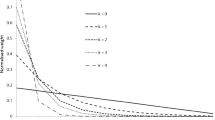Abstract
What would be the analogue of the Lorenz quasi-ordering when the variable of interest is continuous and of a purely ordinal nature? We argue that it is possible to derive such a criterion by substituting for the Pigou–Dalton transfer used in the standard inequality literature what we refer to as a Hammond progressive transfer. According to this criterion, one distribution of utilities is considered to be less unequal than another if it is judged better by both the lexicographic extensions of the maximin and the minimax, henceforth referred to as the leximin and the antileximax, respectively. If one imposes in addition that an increase in someone’s utility makes the society better off, then one is left with the leximin, while the requirement that society welfare increases as the result of a decrease of one person’s utility gives the antileximax criterion. Incidentally, the paper provides an alternative and simple characterisation of the leximin principle widely used in the social choice and welfare literature.

Similar content being viewed by others
Notes
While this operation certainly reduces inequality in a two-person society, things are less obvious when the population consists of more than two individuals. There are indeed good reasons to consider that the fact of bringing two individuals closer in terms of their incomes has the effect of moving them farther apart from the other individuals in the society: for more on this, see, e.g., Magdalou and Moyes (2009).
In this respect, our analysis framework is similar to that used by Tungodden (2000) but our approach differs significantly from his.
Actually, the same holds true for the Lorenz criterion that is the intersection of weak supermajorisation—or, equivalently, generalised Lorenz dominance—and weak submajorisation.
The adjunction of strong Pareto to the anonymity and Hammond equity conditions suffices for rendering the social preference relation complete. This has to be contrasted to what happens in the standard framework: imposing that the social welfare function is monotone increasing in addition to being Schur-concave does not make the corresponding dominance criterion complete.
This is readily inferred from the fact that, in a cardinal framework, a progressive transfer is but a particular case of a Hammond progressive transfer.
Questionnaire studies have highlighted the fact that a large proportion of respondents do not subscribe to the view according to which a progressive transfer reduces inequality (see for instance Amiel and Cowell 1999). In this respect, a notion like that of a uniform on the right progressive transfer proposed by Magdalou and Moyes (2009), which is closely related to the reduction of deprivation, is more likely to fit the views expressed by the interviewed public.
It must be noted however that, for all the other pairs of individuals \(\{i,j\}\) such that \(i < j\), we have, either\(u_{i}^{(5)}< u_{i}^{(6)}< u_{j}^{(6)} < u_{j}^{(5)}\), or\(u_{i}^{(5)} = u_{i}^{(6)} < u_{j}^{(6)} = u_{j}^{(5)}\).
References
Allison AR, Foster JE (2004) Measuring health inequality using qualitative data. J Health Econ 23:503–524
Amiel Y, Cowell FA (1999) Thinking about inequality. Cambridge University Press, Cambridge
Bossert W, Weymark JA (2004) Utility in social choice. In: Barberà S, Hammond PJ, Seidl C (eds) Handbook of Utility Theory, vol 2. Extensions. Kluwer Academic Publishers, Boston/Dordrecht/London, pp 1099–1177
Dalton H (1920) The measurement of the inequality of incomes. Econ J 30:348–361
Donaldson D, Weymark JA (1998) A quasiordering is the intersection of orderings. J Econ Theory 78:382–387
Fishburn PC, Vickson RG (1978) Theoretical foundations of stochastic dominance. In: Whitmore G, Findlay M (eds) Stochastic dominance. Lexington Books, Lexington, MA, pp 39–113
Gevers L (1979) On interpersonal comparability and social welfare orderings. Econometrica 47:75–89
Gravel N, Magdalou B, Moyes P (2018) Ranking distributions of an ordinal variable. Mimeo
Hammond PJ (1976) Equity, Arrow’s conditions and Rawls’ difference principle. Econometrica 44:793–803
Hammond PJ (1979) Equity in two person situations: Some consequences. Econometrica 47:1127–1135
Kolm S-C (1997) Justice and equity. The MIT Press, Cambridge
Kolm S-C (1999) The rational foundations of income inequality measurement. In: Silber J (ed) Handbook of income inequality measurement. Kluwer Academic Publishers, Boston/Dordrecht/London, pp 19–100
Levy H (1998) Stochastic dominance. Investment decision making under uncertainty. Kluwer Academic Publishers, Dordrecht
Magdalou B, Moyes P (2009) Deprivation, welfare and inequality. Soc Choice Welf 32:253–273
Marshall AW, Olkin I (1979) Inequalities: theory of majorization and its applications. Academic Press, New York
Moyes P (1999) Stochastic dominance and the Lorenz curve. In: Silber J (ed) Handbook of income inequality measurement. Kluwer Academic Publishers, Boston/Dordrecht/London, pp 199–222
Moyes P (2013) Rearrangements and sequential rank order dominance. J Math Econ 49:278–290
Roberts K (1980) Possibility theorems with interpersonally comparable welfare levels. Rev Econ Stud 47:409–420
Sen AK (1977) On weights and measures: Informational constraints in social welfare analysis. Econometrica 45:1539–1572
Sen AK (1985) Commodities and capabilities. North-Holland, Amsterdam
Shorrocks AF (1983) Ranking income distributions. Economica 50:3–17
Suppes P (1966) Some formal models of grading principles. Synthese 16:284–306
Tungodden B (2000) Egalitarianism: is leximin the only option? Econ Philos 16:229–245
Acknowledgements
This paper forms parts of the research projects The Measurement of Ordinal and Multidimensional Inequalities (Contract No. ANR-16-CE41-0005) and The Preferences for Redistribution: Foundations, Representation and Implications for Social Decisions (Contract No. ANR-15-CE26-0004) of the French National Agency for Research whose financial support is gratefully acknowledged. It has also been supported by LabEx Entrepreneurship (Contract No. ANR-10-LABX-11-01). We are indebted to Alain Chateauneuf, an associate editor and two anonymous referees for very useful comments and suggestions when preparing this version. Needless to say, none of the persons mentioned above should be held responsible for remaining deficiencies.
Author information
Authors and Affiliations
Corresponding author
Rights and permissions
About this article
Cite this article
Gravel, N., Magdalou, B. & Moyes, P. Inequality measurement with an ordinal and continuous variable. Soc Choice Welf 52, 453–475 (2019). https://doi.org/10.1007/s00355-018-1159-8
Received:
Accepted:
Published:
Issue Date:
DOI: https://doi.org/10.1007/s00355-018-1159-8



